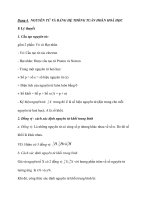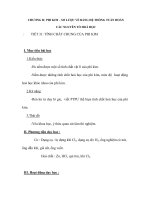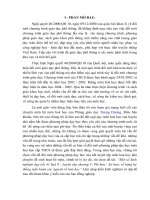TÌM HIỂU VỀ NHÓM IA VÀ IIA TRONG BẢNG HỆ THỐNG TUẦN HOÀN
Bạn đang xem bản rút gọn của tài liệu. Xem và tải ngay bản đầy đủ của tài liệu tại đây (4.49 MB, 69 trang )
TÀI LIỆU THAM KHẢO
Department of Inorganic Chemistry - HUT
1. Hóa học vô cơ – Lê Mậu Quyền
2. Bài tập hóa học vô cơ – Lê Mậu Quyền
3. Hóa học vô cơ – Tập 1, 2, 3 – Hoàng Nhâm
4. Hóa học vô cơ – Tập 1, 2 – Nguyễn Thế Ngôn, Trần Thị Đà
5. Cơ sở lý thuyết hóa học – Phần I: Cấu tạo chất – Nguyễn Đình Chi
6. Modern Inorganic Chemistry – W. L. Jolly
7. Structural Inorganic Chemistry – A. F. Wells
8. Shriver, Atkins, Inorganic Chemistry (3rd ed, 1999)
W.H. Freeman and Company (Chs. 2, 18 )
9. A.R. West, Basic Solid State Chemistry (2nd ed. 1999)
Wiley, New York, 1999
10.C. N. R. Rao, University General Chemistry (18nd 2006), MACMILLAN
INDIA LTD,
11.
12.
13.
14. />15. />16. />wf
THE S-BLOCK ELEMENTS
Introduction
Modern chemical knowledge is based largely on
principles that answer the “why” as well as the
“how-to.”
In the remaining chapters, we will emphasize
facts and applications, but we will refer to
underlying principles repeatedly.
•
Four of the 14 elements that comprise the s-
block elements are somewhat unusual cases,
although not all for the same reason.
–
Hydrogen is the simplest element, with one proton and one electron, and its behavior is rather special.
–
Helium lies in the s-block but its electron configuration fits with the noble gases, and it will be considered in the next
chapter.
–
Francium and radium are highly radioactive and we will not consider them further.
GROUP IA: THE ALKALI METALS
Spodumene LiAl(SiO
3
)
2
The Alkali Metals
•
–
Sodium and potassium (1807) by electrolysis.
–
Cesium (1860) and rubidium (1861) from emission spectra.
–
Francium (1939) from actinium radioactive decay.
•
–
Natural brines are good sources.
–
Natural deposits allow mining of solids.
Flame
Colors
Properties and Trends in Group 1A
•
regular
•
Irregular
!
" #$
•
%
•
& '
( ) '
'
Diagonal Relationships:The Special Case of Lithium
*'
–
Lithium carbonate, fluoride, hydroxide, and phosphate are much less water
soluble than those of other alkali metals.
–
Lithium is the only alkali metal that forms a nitride (Li3N).
–
When it burns in air, lithium forms a normal oxide (Li2O) rather than a
peroxide or a superoxide.
–
Lithium carbonate and lithium hydroxide decompose to form the oxide on
heating, while the carbonates and hydroxides of other Group 1A metals are
thermally stable.
Diagonal
Relationships
The elements in
each encircled
pair have
several similar
properties.
Occurrence, Preparation, Use, & Reactions of the Alkali Metals
•
+
brines !,- $
•
/
spodumene,/!+0
1
$
2
•
ion
atom'(
reduction.
•
3
•
45
•
Liquid sodium is used as a heat transfer medium in
some types of nuclear reactors and in automobile
engine valves, and its vapor is used in lamps for
outdoor lighting.
•
Potassium is used in making KO
2
, used as an oxygen
source for miner’s “self-rescuers” and similar devices:
Lithium is used in lightweight batteries of the type
found in heart pacemakers, cellular telephones,
digital cameras, and portable computers.
Occurrence, Preparation, Use, & Reactions of the Alkali Metals
2 2 2 2 2 3 2 3 2
2 2 2Na O KO CO Na CO K CO O+ + → + + 6
Group I Compounds
•
Halides
–
NaCl 50 million
tons/year in U.S.
–
Preservative, used
on roads, water
softener regeneration,
feedstock for other chemicals
–
KCl from natural brines.
–
Plant fertilizers, feedstock.
Important Compounds of
Lithium, Sodium, and Potassium
•
/
%
–
Li2CO3(aq) + Ca(OH)2(aq) CaCO3(s) + 2 LiOH(aq)
•
0/07-0
2
%
–
2 LiOH(s) + CO2(g) Li2CO3(aq) + H2O
•
,-
!89: $
*
'
''''
Carbonates
•
/
2
-0
1
–
Used to treat manic depression (1-2 g/day).
•
,
2
-0
1
–
Currently mined from rich U.S. resources but can be manufactured by the
Solvay process (E. Solvay, Belgium, 1838-1922).
Production and Use
2 NaCl(l) → 2 Na(l) + Cl
2
(g)
Electrolysis:
KCl(l) + Na(l) → 2 NaCl(l) + K(g)
Sodium as a reducing agent:
TiCl
4
+ 4 Na → Ti + 4 NaCl
Preparation of Sodium
Compounds from NaCl
The methods of preparation suggested by this diagram are not
necessarily the preferred industrial methods.
The Solvay Process—One Way
to Diagram an Industrial Process
The Alkali Metals and Living Matter
•
7 ' ''
'
+
9;<
•
+ =
=
•
>
'
•
/
"#
?
Sodium Sulfate
H
2
SO
4
(conc. aq) + NaCl(s) → NaHSO
4
(s) + HCl(g)
NaHSO
4
(s) + NaCl(s) → Na
2
SO
4
(s) + HCl(g)
In the Kraft Process for making paper:
Na
2
SO
4
(s) + 4 C(s) → Na
2
S(s) + 4 CO(g)
45 kg/ton paper









